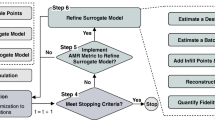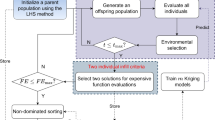Abstract
We investigate the effectiveness of approximation strategy in a surrogate-assisted fireworks algorithm, which obtains the elite from approximate fitness landscape to enhance its optimization performance. We study the effectiveness of approximation strategy from the aspects of approximation method, sampling data selection method and sampling size. We discuss and analyse the optimization performance of each method. For the approximation method, we use least square approximation, spline interpolation, Newton interpolation, and support vector regression to approximate fitness landscape of fireworks algorithm in projected lower dimensional, original and higher dimensional search space. With regard to the sampling data selection method, we define three approaches, i.e., best sampling method, distance near the best fitness individual sampling method, and random sampling method to investigate each sampling method’s performance. With regard to sample size, this is set as 3, 5, and 10 sampling data in both the approximation method and sampling method. We discuss and compare the optimization performance of each method using statistical tests. The advantages of the fireworks algorithm, a number of open topics, and new discoveries arising from evaluation results, such as multi-production mechanism of the fireworks algorithm, optimization performance of each method, elite rank, interpolation times and extrapolation times of elites are analysed and discussed.


Similar content being viewed by others
References
Brest J, Greiner S, Boskovic B, Mernik M, Zumer V (2006) Self-adapting control parameters in differential evolution: a comparative study on numerical benchmark problems. IEEE Trans Evol Comput 10(6):646–657
Gong W, Cai Z, Ling CX, Li C (2011) Enhanced differential evolution with adaptive stategies for numerical optimization. IEEE Trans Syst Man Cybern 41(2):397–413
Hazewinkel M (2001) Encyclopedia of mathematics, chapter Spline interpolation. Springer, New York
Janecek A, Tan Y (2011) Swarm intelligence for non-negative matrix factorization. Int J Swarm Intell Res (IJSIR) 2(4):12–34
Jin Y (2005) A comprehensive survey of fitness approximation in evolutionary computation. Soft comput 9(1):3–12
Kashan AH (2015) A new metaheuristic for optimization: optics inspired optimization (OIO). Comput Oper Res 55:99–125
Ong Y-S, Lim MH, Chen X (2010) Research frontier: memetic computation—past, present and future. IEEE Comput Intell Mag 5(2):24–31
Pei Y (2014) Chaotic evolution: fusion of chaotic ergodicity and evolutionary iteration for optimization. Natural Comput 13(1):79–96
Pei Y (2014) Study on effecient search in evolutionary computation. Doctoral Dissertation, Kyushu University, Japan
Pei Y (2015) From determinism and probability to chaos: chaotic evolution towards philosophy and methodology of chaotic optimization. Sci World J 704587
Pei Y, Takagi H (2012) Fourier analysis of the fitness landscape for evolutionary search acceleration. In: 2012 IEEE Congress on Evolutionary Computation (CEC2012), Brisbane, Austrilia, pp 2934–2940
Pei Y, Takagi H (2013) Accelerating IEC and EC searches with elite obtained by dimensionality reduction in regression spaces. J Evolut Intell 6(1):27–40
Pei Y, Takagi H (2013) Fitness landscape approximation by adaptive support vector regression with opposition-based learning. In: 2013 IEEE International Conference on Systems, Man, and Cybernetics (SMC2013), Manchester, UK, pp 1329–1334
Pei Y, Takagi H (2013) Triple and quadruple comparison-based interactive differential evolution and differential evolution. In: Foundations of Genetic Algorithms Workshop XII (FOGA 2013), Adelaide, Australia, pp 173–182
Pei Y, Takagi H (2015) Local information of fitness landscape obtained by paired comparison-based memetic search for interactive differential evolution. In: 2015 IEEE Congress on Evolutionary Computation (CEC2015), Sendai, Japan, pp 2215–2221
Pei Y, Takagi H (2012) Comparative study on fitness landscape approximation with fourier transform. In: 2012 Sixth International Conference on Genetic and Evolutionary Computing (ICGEC2012), Kitakyushu, Japan, pp 400–403
Pei Y, Zheng S, Tan Y, Takagi H (2012) An empirical study on influence of approximation approaches to enhance fireworks algorithm. In: 2012 IEEE International Conference on Systems, Man, and Cybernetics (SMC2012), Seoul, Korea, pp 1322–1327
Qin AK, Huang VL, Suganthan PN (2009) Differential evolution algorithm with strategy adaptition for global numberical optimization. IEEE Trans Evol Comput 13(2):398–417
Sadollah A, Eskandar H, Bahreininejad A, Kim JH (2015) Water cycle algorithm with evaporation rate for solving constrained and unconstrained optimization problems. Appl Soft Comput 30:58–71
Suganthan PN, Hansen N, Liang JJ, Deb K, Chen YP, Auger A, Tiwari S (2005) Problem definitions and evaluation criteria for the CEC2005, special session on real-parameter optimization. KanGAL Report 2005005:2005
Takagi H (2001) Interactive evolutionary computation: fusion of the capabilities of EC optimization and human evaluation. Proc IEEE 89(9):1275–1296
Takagi H, Ingu T, Ohnishi K (2003) Accelerating a GA convergence by fitting a single-peak function. J Jpn Soc Fuzzy Theory Intell Inform 15(2):219–229 in Japanese
Tan Y, Zhu Y (2010) Fireworks algorithm for optimization. In: Advances in Swarm Intelligence, Springer, New York, pp 355–364
Zhang B, Zhang M-X, Zheng Y-J (2014) A hybrid biogeography-based optimization and fireworks algorithm. In: 2014 IEEE Congress on Evolutionary Computation (CEC2014), Beijing, China, pp 3200–3206
Zhang J, Sanderson AC (2009) JADE: adaptive differential evolution with external achive. IEEE Trans Evol Comput 13(5):945–958
Zheng S, Janecek A, Tan Y (2013) Enhanced fireworks algorithm. In: 2013 IEEE Congress on Evolutionary Computation (CEC2013), Cancun, Mexico, pp 2069–2077
Zheng YJ (2015) Water wave optimization: a new nature-inspired metaheuristic. Comput Oper Res 55:1–11
Zheng YJ, Qin S, Chen SY (2013) Multiobjective fireworks optimization for variable-rate fertilization in oil crop production. Appl Soft Comput 13(11):4253–4263
Acknowledgments
This work was supported by the JSPS Grant-in-Aid for Scientific Research (23500279), Japan. This work was also supported by the Natural Science Foundation of China (NSFC) under grant no. 61375119 and 61170057, and partially supported by National Key Basic Research Development Plan (973 Plan) Project of China with grant no. 2015CB352302.
Author information
Authors and Affiliations
Corresponding author
Rights and permissions
About this article
Cite this article
Pei, Y., Zheng, S., Tan, Y. et al. Effectiveness of approximation strategy in surrogate-assisted fireworks algorithm. Int. J. Mach. Learn. & Cyber. 6, 795–810 (2015). https://doi.org/10.1007/s13042-015-0388-8
Received:
Accepted:
Published:
Issue Date:
DOI: https://doi.org/10.1007/s13042-015-0388-8




